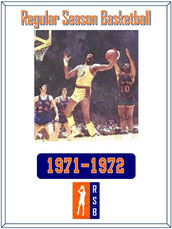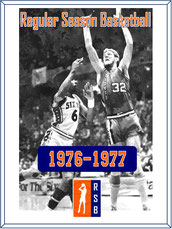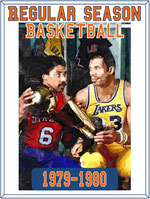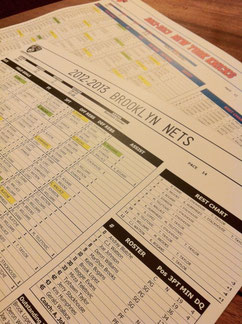NBA seventies

NBA 1971-‘72: 17 teams
Season Recap:
The 1971–72 NBA season was the 26th season of the National Basketball Association. The season ended with the Los Angeles Lakers winning the NBA Championship, beating the New York Knicks 4 games to 1 in the NBA Finals.
As the 25th anniversary of the founding of the modern NBA, the league unveiled a new logo (the actual), to commemorate the occasion. It features the white silhouette of a basketball player dribbling, framed by red and blue. Jerry West of the Los Angeles Lakers was used as the model for the logo. Coincidentally, Jerry West would win the only NBA Championship of his career during the season.
The Los Angeles Lakers came into the season returning a strong squad from their playoff run a year before. Elgin Baylor announced his retirement after 13 seasons, but despite his retirement, the Lakers went on a 33-game winning streak, completing two undefeated months, ì14–0 in November and 16–0 in December. On March 20, 1972, the Lakers beat Golden State by a record 63 points (162–99), a mark that would stand until 1991, when Cleveland beat Miami by 68 points (148–80). The Lakers finished the season with a record 69 wins, which would stand until the 1995–96 season when the Chicago Bulls won 72 regular season games (unbeaten record).
The defending champion Milwaukee Bucks won 63 games on the play of renamed Kareem Abdul-Jabbar, formerly Lew Alcindor. The Celtics, led by point guard Jo Jo White and 32-year-old swingman John Hondo Havlicek, won the Atlantic division with 56 wins. Boston had recovered from the retirement of Bill Russell, K. C. Jones and Sam Jones by winning 12 more games than the previous season.
In the first round of the Playoffs, the Lakers swept the Bulls and Milwaukee defeated Golden State. New York eliminated the Bullets and Boston won against the Atlanta Hawks. In the Western Conference Finals, the Lakers lost game 1 versus the Bucks at The Forum 116–72, but a Lakers squad led by assist champion Jerry West, leading scorer Gail Goodrich, and veteran Wilt Chamberlain beat Milwaukee in six games. In the Eastern Conference Finals, New York defeated the top-seed Celtics in five games.
In the NBA Finals, New York won game 1 very easily, but Los Angeles won game 2 106–92 to even the series. In game 3, the Lakers jumped out to a 22-point lead and regained home-court advantage with a 107–96 win. In game 4, the Knicks forced overtime. At the end of regulation, Wilt Chamberlain was called for his fifth foul. In his first 12 seasons, he had never fouled out of a game. Chamberlain did not foul out and led the Lakers to a 116-111 victory, but he broke his wrist in the overtime period. The Lakers held a 3–1 series lead going into game 5 in Los Angeles. In game 5, Chamberlain played despite his injury. The score was tied at 53 in the first half, but the Lakers outscored the Knicks 61–47 in the second half to win the game and the NBA Championship, 114–100.
(Source Wikipedia)
TO BUY THIS SEASON: ONLY 16 $ FOR ALL THE 17 TEAMS!
ADVANCED RULES INCLUDED.
WITH NEW TEAM CHARTS TEMPLATE!

NBA 1972-'73: 17 Teams
Season Recap:
The defense-oriented New York Knicks were so well-balanced that none of their players finished the 1972-73 season among the individual stats leaders except for Bill Bradley, who finished fifth in
free-throw percentage.
Adding to that balance was guard Earl Monroe, whom the Knicks acquired earlier in the previous season, teamed with Walt Frazier in the backcourt to wreak havoc on opposing guards.
During the regular season, 6' 1" Nate “Tiny” Archibald pulled off the amazing by leading the league in scoring (34.0 ppg) and assists (11.4 apg). His Kings, who had moved from Cincinnati (where
they were the Royals), divided their home games between Kansas City and Omaha. Though the Kings finished 36-46 and were one of the league’s worst teams, Archibald still accomplished his feat
while also playing a league-leading 46 minutes a game. While the Kings had their bright spot in Archibald, there surely wasn’t anything positive in Philadelphia this season. Losing star forward
Billy Cunningham to the upstart ABA, the Sixers suffered through a 9-73 season - the worst finish in league history.
Boston seemed like the title favorite during the season as it rolled up a franchise-record 68 wins and boasted the league’s MVP, center Dave Cowens. In the playoffs, they breezed past the Hawks
in six games, setting up a showdown with the Knicks. The Knicks made it look easy. Bradley, Willis Reed, Dave DeBusschere, Monroe and Frazier led the charge and Jerry Lucas and Phil Jackson - two
key reserves - helped the Knicks waltz past Baltimore in the Eastern Conference semifinals.
Although it went seven games, the Knicks-Celtics conference finals had its fair share of blowouts and close calls. Yet in Game 7, the Knicks won 94-78 at Boston Garden to return to The
Finals.
In The Finals, the Knicks dropped Game 1 to the Lakers, then won four straight closely contested games for the Knicks’ second NBA title. It was the last Finals appearance for all-time great
center Wilt Chamberlain. For his career, Chamberlain had taken three different teams to seven Finals appearances, winning twice.
(NBA.com source)
TO BUY THIS SEASON: ONLY 16 $ FOR ALL THE 17 TEAMS!
ADVANCED RULES INCLUDED.
WITH NEW TEAM CHARTS TEMPLATE!

NBA 1974-‘75: 18 teams
Season Recap:
The Golden State Warriors, with a record of 48-34, had low expectations against the defending champions Boston Celtics and the Washington Bullets, both whom finished with records of 60-22. But with a remarkable playoffs run, they obtained one of the most unusual and impressive championships ever.
In the Regular season Boston and Washington, both in the East, dominate the league with 60 wins each, guided by Cowens and Havlicek the Celtics, Hayes and Unseld the Bullets. No other team in the league won over 50 games, a surprising fact, with nine teams did win 40 games or more to show the rising balance of the league. The best of these were Buffalo, Golden State and Chicago. The firsts lead by sensational forward and league MVP Bob McAdoo (34.5 PPG), the Warriors future champions and the Bulls that fought off the Milwaukee Bucks for the Mid West supremacy, after the retirement of Robertson.
In the Playoffs the Bullets eliminate McAdoo’s Braves in seven games while the Celtics came in 5 over the Rockets. In the West Warriors and Bulls eliminated Sonics and Kings in six. The Conference Finals were real battles: Boston and Washington played for many the real Finals, saw the Bullets prevailing in six games thanks to the opener win in Boston. Warriors and Bulls played a classic offense vs defense series in which the Warriors down 3-2 went to the Finals after two tight games. In the Finals Golden State sweep the Bullets winning the opener on the road, game two and three at home and closing the series at Washington with one point-win, with Rick Barry averaged 28 points to be the Finals MVP.
(Source Wikipedia)
TO BUY THIS SEASON: ONLY 16 $ FOR ALL THE 18 TEAMS!
ADVANCED RULES INCLUDED.
WITH NEW TEAM CHARTS TEMPLATE!

NBA 1976-‘77: 22 teams
Season Recap:
The 1976-77 season was a time of change in pro basketball. Four teams from the disbanded ABA (the New York Nets, Indiana Pacers, Denver Nuggets and San Antonio Spurs) became NBA franchises. A dispersal draft was used to allocate other ABA players, including 7-foot-2 Artis Gilmore, who went to the Chicago Bulls, and superstar Julius Erving, who was signed by the Philadelphia 76ers.
The NBA now had 22 teams, and the playoff system was restructured so that 12 teams qualified and each of the four division winners received a bye through the first round.
The Portland Trail Blazers snared Maurice Lucas from the ABA, and his addition helped propel the Bill Walton-led team to an unlikely NBA championship. The Portland franchise had gone six seasons without a winning record, but with Walton healthy and Lucas bringing toughness, rebounding and scoring, the Jack Ramsay-coached squad prospered.
Before 1977, many fans barely acknowledged that Portland had been fielding a team in the NBA. The Trail Blazers didn't command respect, averaging 28 wins in six seasons and failing to earn a playoff berth. But in just one magical season, NBA fans everywhere were introduced to "Blazermania."
The Pacific Northwest embraced the Blazers and Walton, their decidedly unconventional red-haired center from California.
In the playoffs, Portland beat Chicago, Denver and Los Angeles to reach The Finals, where they faced the Erving-led 76ers. Philadephia won the first two games at home. Then Walton cut his long red hair, and Portland reeled off four straight wins, spawning Blazermania and the term "Rip City," from the sound a shot makes when it rips through nothing but net.
(Source NBA.com)
TO BUY THIS SEASON: ONLY 18 $ FOR ALL THE 22 TEAMS!
ADVANCED RULES INCLUDED.
WITH NEW TEAM CHARTS TEMPLATE!

NBA 1977-‘78: 22 teams
Season Recap:
Two violent incidents cast a shadow over the game in 1977-78.
Kareem Abdul-Jabbar punched Milwaukee rookie center Kent Benson, breaking his hand and drawing a $5,000 fine from commissioner Larry O'Brien. Abdul-Jabbar missed 20 games, hurting the Lakers chances in the Playoffs. Benson missed fewer games, but he never fulfilled the promise he'd shown as a collegian at Indiana.
An even more serious incident occurred in December. Kermit Washington, a powerfully built forward for the Lakers, got into a fight with Houston center Kevin Kunnert. As Houston's star forward Rudy Tomjanovich ran toward the combatants, Washington turned and swung his fist, inflicting massive injuries to Tomjanovich's jaw, eye and cheek. Washington was fined and suspended for two months, costing him more than $50,000 in salary.
The scoring title for the 1977-78 season went to San Antonio's George Gervin by .07 of a point. Gervin scored 63 points in the season finale to edge Denver's David Thompson 27.22 to 27.15. Just hours before, Thompson had scored 73 points against Detroit in his season finale.
Portland had won a league-high 58 games, but saw its playoff chances dwindle with injuries to several players, most notably Bill Walton. Instead, two Cinderella teams, Washington and Seattle, neither of which had won its division, advanced to The Finals.
Washington rebounded from a 3-2 deficit to defeat Seattle on its home court in Game 7.
The Bullets featured hard-driving coach in Dick Motta and 10-time NBA All-Star Elvin Hayes. Though they were vastly different personalities, in 1978 the two compromised their different basketball philosophies enough to secure the only NBA title in Bullets history. It proved to be the only championship for Hayes, who played in 1,303 NBA games, and Motta, who coached in 1,719 NBA games.
"We had such diverse talent on that team," Hayes said. "We had Mitch Kupchak, Larry Wright, Charles Johnson and Greg Ballard all coming off the bench. Any one of those guys would have been a great starter on another team. For starters, we had Unseld, (Kevin) Grevey, Tommy Henderson, Bobby Dandridge and myself. From the bench to the starters, we had great balance."
(Source NBA.com)
TO BUY THIS SEASON: ONLY 18 $ FOR ALL THE 22 TEAMS!
ADVANCED RULES INCLUDED.
WITH NEW TEAM CHARTS TEMPLATE!

NBA 1979-‘80: 22 teams
Season Recap:
Although the season would forever be known as the year Larry Bird and Earvin "Magic" Johnson entered the league, several other important changes also occurred. The 3-point field goal, a popular facet of the ABA game, was adopted by the league. The New Orleans Jazz moved to Salt Lake City and took the unlikely team name of Utah Jazz. And the schedule was altered so that teams faced rivals in their own division more often than teams from other divisions.
But the big story of the season was the arrival of two charismatic and talented rookies, Bird and Johnson, materializing on opposite coasts on the rosters of two of the NBA's most successful franchises.
The turnaround in Boston was dramatic. Havlicek had retired after the 1978 season, and Boston went 29-53 in 1979. Along with Bird, the Celtics still had former MVP Dave Cowens and third-year forward Cedric Maxwell up front, Nate Archibald and Chris Ford in the backcourt. The team posted a remarkable 61-21 record, a 32-game improvement. But Philadelphia won 59 games and behind Julius Erving's stellar play, defeated the Celtics in five games to advance to the Finals.
In Los Angeles, the Lakers experienced a little "Magic", as Johnson's enthusiasm seemed to rejuvenate Kareem Abdul-Jabbar, propelling the Lakers to 60 wins and a berth in the NBA Finals. Abdul-Jabbar, who hadn't won an NBA title since 1971 with Milwaukee, dominated the NBA Finals as Johnson fed him the ball in all the right spots in the first five games. But Abdul-Jabbar badly twisted an ankle in Game 5, and couldn't make the trip to Philadelphia for Game 6. The Lakers, figuring they had nothing to lose, came out and played loose in the Spectrum. Jamaal Wilkes enjoyed one of the finest games of his career and finished with 37 points. But the newspapers the next day heralded the only headline possible "It's Magic!" Johnson, filling in for Abdul-Jabbar as the starting center and eventually playing every position in the court, scored 42 points, added 15 rebounds and seven assists as the Lakers wrapped up the title.
"We know you're hurting, big fella," Johnson said over live television for all America, and Abdul-Jabbar, to hear. "But we want you to get up and do a little dancin' tonight."
(Source NBA.com)
TO BUY THIS SEASON: ONLY 18 $ FOR ALL THE 22 TEAMS!
ADVANCED RULES INCLUDED. THREE POINT "EARLY DAYS" RULE EFFECTIVE!
WITH NEW TEAM CHARTS TEMPLATE!
You can do it, too! Sign up for free now at https://www.jimdo.com





